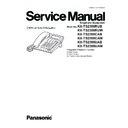Panasonic KX-TS2388RUB / KX-TS2388RUW / KX-TS2388CAB / KX-TS2388CAW / KX-TS2388UAB / KX-TS2388UAW Service Manual ▷ View online
5
KX-TS2388RUB/KX-TS2388RUW/KX-TS2388CAB/KX-TS2388CAW/KX-TS2388UAB/KX-TS2388UAW
2.2.1.
Suggested PbF Solder
There are several types of PbF solder available commercially. While this product is manufactured using Tin, Silver, and Copper
(Sn+Ag+Cu), you can also use Tin and Copper (Sn+Cu) or Tin, Zinc, and Bismuth (Sn+Zn+Bi). Please check the manufac
turer's specific instructions for the melting points of their products and any precautions for using their product with other materi-
als. The following lead free (PbF) solder wire sizes are recommended for service of this product: 0.3 mm, 0.6 mm and 1.0 mm.
(Sn+Ag+Cu), you can also use Tin and Copper (Sn+Cu) or Tin, Zinc, and Bismuth (Sn+Zn+Bi). Please check the manufac
turer's specific instructions for the melting points of their products and any precautions for using their product with other materi-
als. The following lead free (PbF) solder wire sizes are recommended for service of this product: 0.3 mm, 0.6 mm and 1.0 mm.
2.3.
Discarding of P. C. Board
When discarding P. C. Board, delete all personal information such as telephone directory and caller list or scrap P. C. Board.
0.3mm X 100g
0.6mm X 100g
1.0mm X 100g
6
KX-TS2388RUB/KX-TS2388RUW/KX-TS2388CAB/KX-TS2388CAW/KX-TS2388UAB/KX-TS2388UAW
3 Specifications
Note:
• Design and specifications are subject to change without notice.
Power Source:
From telephone line
From 3 AA (LR6, R6, UM-3) batteries
From 3 AA (LR6, R6, UM-3) batteries
Memory Capacity:
50 Caller ID memory, 50 Directory memory.
Redial:
The unit redials the last dialed number
Microphone:
Electret condenser microphone
Input Jack:
Telephone Line
Approx. 93 mm x 172 mm x 220 mm
Dimensions (H x W x D):
Mass (weight):
Mass (weight):
Approx. 550
Operating Enviroment:
0
o
C - 40
o
C, 20 % - 80 % relative air humidity (dry)
g
Speaker Unit:
Unit: 5.7cm (2.5") PM magnetic type 32
Handset: 3 cm (1
13
/
16
") PM dynamic type 150
7
KX-TS2388RUB/KX-TS2388RUW/KX-TS2388CAB/KX-TS2388CAW/KX-TS2388UAB/KX-TS2388UAW
4 Technical Descriptions
4.1.
Block Diagram
1
R
5
D ,
3
D
1
C
P
1
T
P
S
D1
C1
MIC (2AP)
6
D ,
4
D
1
CI
D601
Q107
Q101, Q103
D101
T
IC601
Handset/Headset
R
SP
MIC
Q108
IC201, Q201
D302
Q110
D301
IC871
IC302
IC831
1AP PCB
D505
IC861
IC651
4.5V
2AP PCB
IC501, Q501, Q502
Batter
y
LCD
KX-TS880 /
TS2388 Ser
ies :
BLOCK DIA
GRAM
Q422
Q401, Q402, Q403
IC801
MICON
Ringer indication LED
LED1 (Small PCB)
JOHN SMITH
1234567890
RINGER
IC
INUSE / EXHOOK
Line
ON/OFF
Handset Receiving
Amp
EEPR
OM
128K
TIPIN
Sidetone
Br
idge
RESET
BA
TTLO
W
Reset IC
2.7V
Handset
Sending
Amp
K
e
yboard
Switch
RIN
GIN
Batter
y
Lo
w
Detector
Regulator
3.3 V
FSK / DTMF Circuit
W
a
k
eup Circuit
WAK
EU
P
Dumm
y Ringer
Circuit
SP-Phone
Circuit
Expander
I/O IC
DRIN
G
DTM
F
Dial T
o
ne
Detect
Ex-Hook
Detect
T
O
NE_DET
In Use
Detect
PGAIN2
RING_
DET
D801
8
KX-TS2388RUB/KX-TS2388RUW/KX-TS2388CAB/KX-TS2388CAW/KX-TS2388UAB/KX-TS2388UAW
4.2.
Circuit Operation
4.2.1.
Bell Detector Circuit
When the bell signal is input from LINE to T/R (when the telephone rings), the signal is output at the speaker via the following
path :
T/R
path :
T/R
R1/C1 D1/LED1 (small PCB) D3/D4 IC1 (pin8) IC1 (pin5) PC1 C5 SW2 (R7/R8/R9) T1 Speaker
4.2.2.
Dummy Ringer Circuit
When {AOH} button is pressed during incoming call (Caller ID AOH mode), dummy ring function will be activated.
The bell signal from LINE stops and Caller ID is received.
Set will keep on ringing by the dummy ring function until the handset is picked up / speakerphone is on.
The bell signal from LINE stops and Caller ID is received.
Set will keep on ringing by the dummy ring function until the handset is picked up / speakerphone is on.
The dummy ring signal is generated from IC801 via the following path :
(Speakerphone will be activated during dummy ring)
IC801 (pin 89)
(Speakerphone will be activated during dummy ring)
IC801 (pin 89)
R901 Q2 SW2 ( R11/R12/R13 ) C8 R615 C616 IC601 (pin 19) IC601 (pin 15) C618
Speaker
4.2.3.
Telephone Line Interface
4.2.3.1.
Circuit operation
• On hook
Q101 is OFF, on-hook condition where DC loop is disconnected and voice signal flow is cut.
• Off hook
During Off-Hook, pin 1_3 of SW101 and Q101 is ON, providing an off-hook condition (active DC current flow through the circuit)
and the following is the signal flow :
T
and the following is the signal flow :
T
POS101 L101 D101(+) Q101 R180 Q107 R119 D103 D101(-) L102 R
• Receiving signal flows:
LINE
Q101 R180 C109 C401 R401 L412 L401 Q401 C404 R405 R417 L405 C405 L406
Q402 C408 R413 L409 Q403 C410 VR401 SP (handset)
• Transmission signal flows:
MIC (handset)
C422 VR402 R423 C425 L421 R430 Q422 R429 C429 L107 Q107 Q101
R180
LINE
• Pulse Dial
A pulse signal switches repeatedly between high and low logic is output from IC801 (pin 73), on and off the line loop, generating
the pulse dial signal.
the pulse dial signal.
Click on the first or last page to see other KX-TS2388RUB / KX-TS2388RUW / KX-TS2388CAB / KX-TS2388CAW / KX-TS2388UAB / KX-TS2388UAW service manuals if exist.

